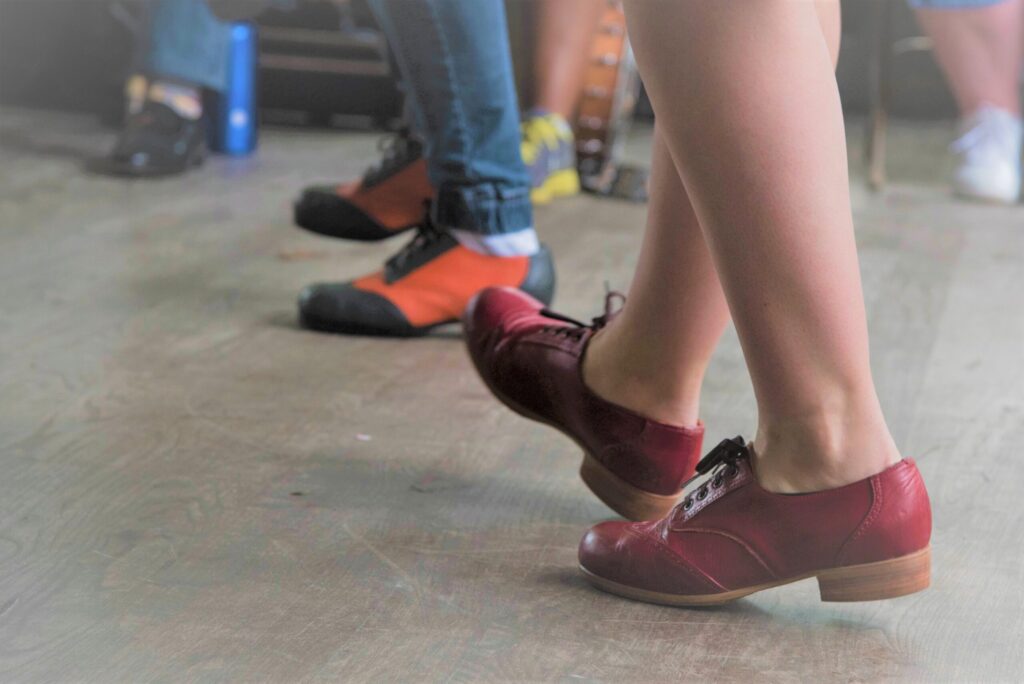During some intensive spring cleaning, my family stumbled across a couple pairs of clogging shoes from approximately 1998. My parents moved to Wheeling shortly after I was born. In an effort to immerse themselves in their new environment, my parents and grandparents took clogging classes. I’ve heard stories of my grandpa’s comical attempts to clog throughout my life, and despite being absent from the clogging classes (I was an infant at the time), the shoes triggered imagined memories of the stories I’d heard growing up. Seeing the shoes and listening to their distinctive sound sparked internal questions about how this dance came to be a cultural beacon. How did clogging become so intwined with Appalachian culture that it was the first way my young parents sought to engage with their new community? What blend of Appalachian traditions and peoples does clogging reflect?
The Augusta Collection contains oral histories and dance recordings that have guided my research. When I began looking at Augusta’s recordings of clogging, I inevitably discovered flatfooting, which developed alongside clogging. While clogging is more choreographed and involves higher footwork, flatfooting allows for improvisation and dancers keep their feet flat and low to the ground. Both forms are practiced in Appalachia and during the summers at Augusta. In one video, a group of two men and two women performed a highly choreographed clogging routine. I was enthralled with the synchronicity of their movements, and in turn, tickled by the whimsical improvisation in the flatfooting videos.
The diversity of Appalachian history is not always obvious, but clogging is one of many traditions that was planted in Appalachia by immigrants. Its roots are in Ireland, Scotland, and England. During the early- to mid-nineteenth century, and Scot-Irish immigrants sought opportunity in Appalachia and brought early forms of clogging, like the “Lancashire Clog,” with them. African American and Native Americans were also integral contributors to the development of Appalachian clogging. Native Americans influenced the toe-heel steps of clogging. Clogging was also shaped by African “buck dancing,” which originated during slavery. Although discussions of “buck dancing” are part of the history of Appalachian dance, the term developed from whites’ derogatory use of “buck” to describe Black men during slavery. According to Phil Jamison’s Hoedowns, Reels, and Frolics: Roots and Branches of Southern Appalachian Dance, in the late-nineteenth century, white men began performing the dance at minstrel shows in blackface, which eventually lead to more mainstream performances of “buck dancing” by whites. “Buck dancing” not only influenced clogging and flatfooting, but—despite its racially charged history—is still performed today as a unique style of dance by Black and white people. It was historically attached to North Carolina Piedmont and the blues, but in contemporary uses, it is often accompanied by fiddle-based music.
Clogging served in an important social and historical purpose in Appalachia—especially in rural communities. The venues for clogging changed over the years. During the nineteenth and twentieth centuries, community dances often took place in people’s homes. The furniture would be shoved to the sides, rugs were rolled up, and people would dance. In more recent times, dance halls would hold gatherings for square dances, clogging competitions, and figure calling dances. Competition clogging picked up in the twentieth and twenty-first centuries, leading to more innovation in style and a greater focus on performance. Although the setting for clogging has evolved, the practice has been passed down through generations. Improvisation and modernization of the steps are tethered to traditional steps and movements. Clogging is a practice of community memory, with each performance being a retelling of a story about who Appalachians are.
Although clogging is often attached to a very homogenous, rural image of Appalachia, it was perfected by an array of cultures and shaped by the racial histories of this region. After researching the history, I think that clogging is meaningful to Appalachians because it is connected to their roots and brings people together through a shared love of music and dance. When my parents moved to West Virginia, they sought community in their new home, and clog dancing presented a way to engage with new people and cultures. Augusta serves as one of the leading organizations that supports traditional practices like clogging. Augusta’s archives ensure the diversity of its history is preserved, and its camps and performances provide opportunities for people seeking to learn and appreciate clogging and flatfooting.

